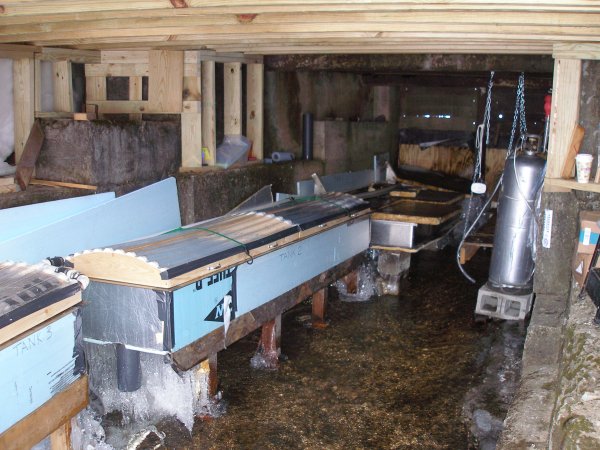
We found that we did not really need much if any heat to maintain temperatures above freezing once everything had gotten thawed out.
Atlantic Salmon 2011
Club members went through some interesting
times in the Winter and Spring of 201. The hatchery survived
both
the cold and
snow of winter and the floods of spring.
| Early in January, 2011 members of the club installed tanks and the necessary plumbing at the dam at McConnellsville. Everything seemed fine as water was flowing through the tanks and we thought we were ready to receive our eggs. Then it got really cold. The temperature was estimated to be -20F overnight in McConnellsville on January 24 and when Paul checked on the hatchery, just about everything was frozen. Paul alerted other members of the club and people brought in propane heaters and got the equipment thawed out. By the 27th water was again flowing through the system. |  We found that we did not really need much if any heat to maintain temperatures above freezing once everything had gotten thawed out. |
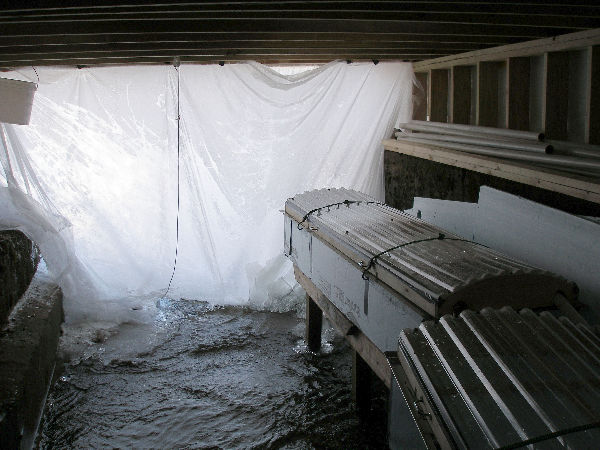 The plastic curtain was doubled and it seemed to work out well in keeping out the cold. Notice the insulation around the tanks. |
A 6 mil plastic curtain was put up enclosing
the open end. This seemed to help a lot as the temperatures
moderated in the hatchery and we no longer had to worry about having
the water in the pipes freeze. On Feb 8, our eggs left the Casco Maine Fish Hatchery and arrived at Paul's house Feb 09, at 11:38 AM. When the box was opened, it was discovered that the Styrofoam trays had broken and collapsed and a couple hundred eggs were lost immediately. On the second day in the hatchery and there were over 2300 eggs that were obviously damaged and had turned white. Some eggs started to hatch right away and in our experience those that hatch so quickly don't have a very high survival rate. Paul set up a schedule for members to attend to the hatchery and to spread the work around. |
| It was decided to keep the snow on the roof
of
the hatchery as it would act as an insulating blanket. It was
a
little treacherous to descend the steps down to the hatchery.
A
rope was fastened that members can grab when descending the steps. After thawing out the plumbing and the tanks and after installing the plastic curtain, the temperatures in the hatchery were consistently above freezing without using the propane heaters. So it appears that next year that heating the inside will be necessary only in extreme conditions. |
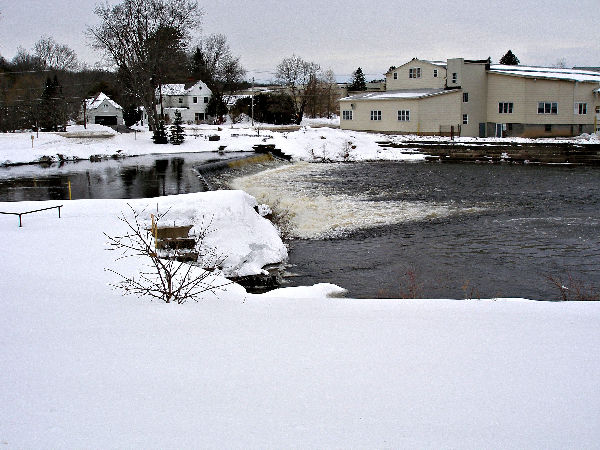 The McConnellsville Hatchery under a blanket of insulating snow. |
April 29, high water, too deep to enter the hatchery. Fish don't drown, humans do. |
In early March water levels started to
become
a problem. The area had gotten a lot of snow over the winter
which melted and then came torrential rains in April. Club
members rushed to the hatchery and secured the tanks before the water
rose too much to allow access to the tanks. The club lost a number of fish due to the high water and sediments deposited by the water. When the water cleared up and flows became more normal, the remaining fish did well. |
| Even though the club lost a lot of fish
during
early 2011, plenty of fish have survived. On May
26, fish
were sent off to the laboratory to be tested. Allowing 4
weeks
for testing, the tentative stocking date will be on June 26, 2011.
Another crisis occurred on June 7, when we started losing fish to a fungal infection. We instituted a more rigorous cleaning procedure and the problem corrected itself but not before we lost several hundred fish. From time to time we would find crayfish in among the fish. There was evidence that they were praying on the fish as some fish looked like they had gotten pinched by the crayfish claws. |
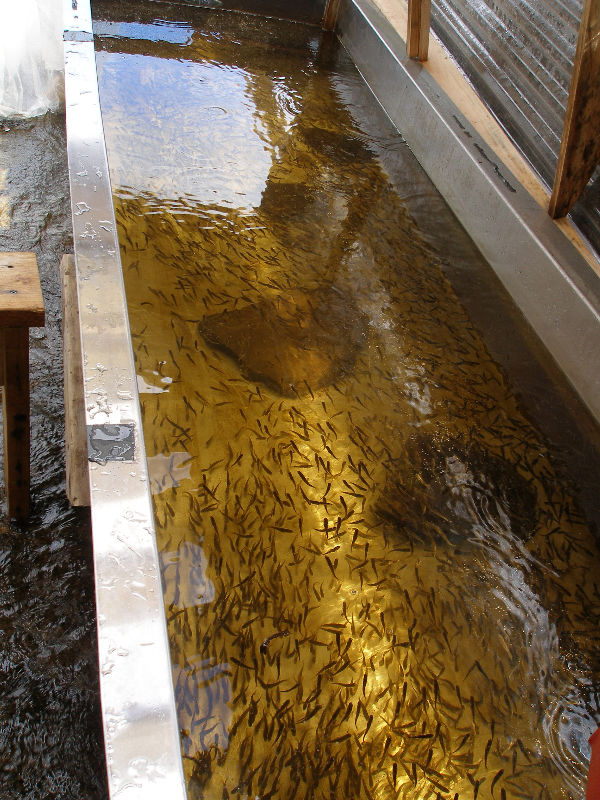 At this stage on May 19 the fry are about an inch long. |
| On
July 2, 2011 club members met at the hatchery in
McConnellsville, NY to stock Atlantic salmon. Paul Miller
again
instructed the volunteers how and where to stock the fish. Coolers and
oxygen were necessary because of the warmer temperatures and the
distances involved in transportation. The fish were first
placed
in heavy duty plastic bags along with water and oxygen and then closed
with an o-ring. The bags were placed in coolers for the trip
to
the stocking sites. The Boy Scouts from North Bay also helped stock fish. |
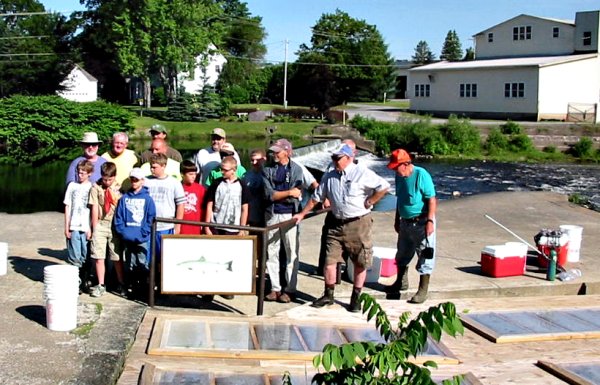 |
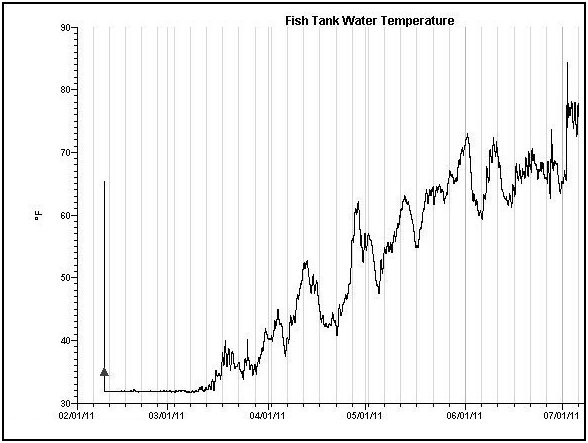 |
One of the concerns that
members have about the hatchery is having the water in the tanks and
pipes freeze. The salmon eggs and fry need a continuous supply of
oxygenated water for their survival. The club borrowed a
recording thermometer to
document the water temperature over time. A double layer of building plastic was placed on the open end of the hatchery. Once the hatchery was sealed from the outside air, no freeze ups occurred. Steps are being made to improve the air tightness of the hatchery and to further increase the insulation from the outside air. |
| One of the probes of the
recording thermometer was left to sample the ambient air in the
hatchery. It was found that the lowest the ambient air
temperature got to was 29.79 degrees. This is especially
encouraging
as the outside temperature was recorded officially nearby at -20
degrees F at
one point during the winter. The water temperatures correlated well with the air temperatures as it warmed up in March. The two graphs can be overlaid to show this point. It has been decided that we should not shovel the snow from the roof as it adds an insulating value. |
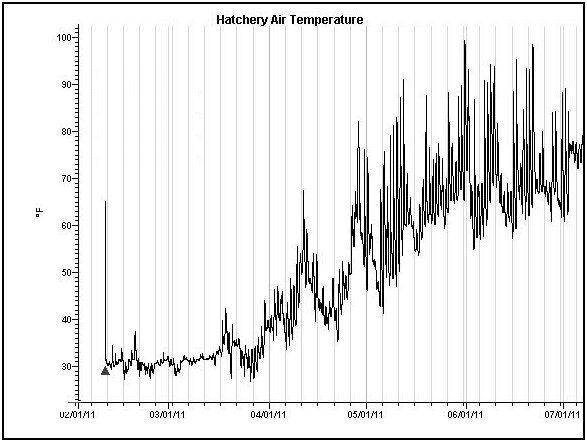 |